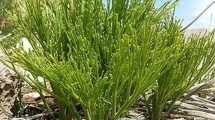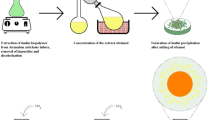Abstract
The presence of humic acid compounds in water resources, as one of the precursors of Trihalomethanes and Holoacetic acids, causes health problems for many communities. The aim of this research study was to investigate the photocatalytic degradation efficiency of humic acid using MnFe2O4@TiO2 nanoparticles which produced by green synthesis method. The synthesis of metal nanoparticles using plant extracts and the study of their catalytic performance is a relatively new topic. Many chemical techniques have been proposed for the synthesis of MnFe2O4@TiO2 nanoparticles, but green synthesis has received much attention due to its availability, simplicity, and non-toxicity. The properties of synthesized nanoparticles were determined by SEM, FT-IR, XRD, EDS, and DLS analysis. The results of the study showed that under optimal experimental conditions (pH = 3, nanocomposite dose = 0.03 g/L, humic acid initial concentration = 2 mg/L, and contact time = 20 min), it is possible to achieve maximum degradation of humic acid. Therefore; MnFe2O4@TiO2 nanoparticles have high efficiency for removing of humic acid from aqueous solutions under UV light.










Similar content being viewed by others
Data availability
All data generated or analyzed during this study are included in this published article.
References
Akbari F, Khodadadi M, Al-Musawi TJ, Varouqa IF, Naghizadeh A (2021) Degradation of humic acid using a solar light-photocatalytic process with a FeNi3 /SiO2 /TiO2 magnetic nanocomposite as the catalyst. Desalin Water Treat 241:135–145
Asgari G, Seidmohammadi A, Salari M, Ramavandi B, Faradmal J (2020) Catalytic ozonation assisted by rGO/C-MgO in the degradation of humic acid from aqueous solution: modeling and optimization by response surface methodology, kinetic study. Desalination Water Treat 174:215–29
Babel S, Sekartaji PA, Sudrajat H (2017) TiO2 as an effective nanocatalyst for photocatalytic degradation of humic acid in water environment. J Water Supply: Res Technol—AQUA 66:25–35
Bora T, Dutta J (2014) Applications of nanotechnology in wastewater treatment. J Nanosci Nanotechnol 14:613–626
Choi MS, Na HG, Shim GS, Cho JH, Kim MY, Kim S-I, Baek S-H, ** C, Lee KH (2021) Simple and scalable synthesis of urchin-like ZnO nanoparticles via a microwave-assisted drying process. Ceram Int 47:14621–14629
Derakhshani E, Naghizadeh A (2018) Optimization of humic acid removal by adsorption onto bentonite and montmorillonite nanoparticles. J Mol Liq 259:76–81
Eslami A, Amini MM, Yazdanbakhsh AR, Mohseni-Bandpei M, Safari AA, Asadi AA (2016) N, S co-doped TiO2 nanoparticles and nanosheets in simulated solar light for photocatalytic degradation of non-steroidal anti-inflammatory drugs in water: a comparative study. J Chem Technol Biotechnol 91:2693–2704
Esmati M, Allahresani A, Naghizadeh A (2021) Synthesis and characterization of graphitic carbon nitride/mesoporous nano-silica (g-C3N4/KCC-1) nanocomposite as a novel highly efficient and recyclable photocatalyst for degradation of antibiotic in aqueous solution. Res Chem Intermed 47:1447–1469
Iravani S (2011) Green synthesis of metal nanoparticles using plants. Green Chem 13:2638
Joolaei H, Vossoughi M, Abadi RM, A. & Heravi, A. (2017) Removal of humic acid from aqueous solution using photocatalytic reaction on perlite granules covered by Nano TiO2 particles. J Mol Liq 242:357–363
Kamani H, Ashrafib D, Jahantiqa A, Norabadia E, Dashti Zadeha M (2021) Catalytic degradation of humic acid using Fe–doped TiO2-ultrasound hybrid system from aqueous solution. INT J ENVIRON ANAL CHEM.
Kamranifar M, Masoudi F, Naghizadeh A, Asri M (2019) Fabrication and characterization of magnetic cobalt ferrite nanoparticles for efficient removal of humic acid from aqueous solutions. Desalin Water Treat 144:233–242
Khodadadi M, Ehrampoush M, Ghaneian M, Allahresani A, Mahvi A (2018) Synthesis and characterizations of FeNi3@ SiO2@ TiO2 nanocomposite and its application in photo-catalytic degradation of tetracycline in simulated wastewater. J Mol Liq 255:224–232
Khodadadi M, Al-Musawi T, Kamani H, Panahi H (2020) The practical utility of the synthesis FeNi3@SiO2@TiO2 magnetic nanoparticles as an efficient photocatalyst for the humic acid degradation. Chemosphere, 239.
Kim JK, Alajmy J, Borges AC, Joo JC, Ahn H, Campos LC (2013) Degradation of humic acid by photocatalytic reaction using nano-sized ZnO/laponite composite (NZLC). Water Air Soil Pollut, 224.
Kord Mostafapour F, Bazrafshan E, Belarak D, Khoshnamvand N (2016) Survey of photo-catalytic degradation of ciprofloxacin antibiotic using copper oxide nanoparticles (UV/CuO) in aqueous environment. J Rafsanjan Univ Med Sci 15:307–318
Lou X, **ao D, Fang C, Wang Z, Liu J, Guo Y, Lu S (2016) Comparison of UV/hydrogen peroxide and UV/peroxydisulfate processes for the degradation of humic acid in the presence of halide ions. Environ Sci Pollut Control Ser 23:4778–4785
Maleki A, Safari M, Rezaee R, Darvishi R, Shahmoradi B, Zandsalimi Y (2016) Photocatalytic degradation of humic substances in the presence of ZnO nanoparticles immobilized on glass plates under ultraviolet irradiation. Sep Sci Technol 51:2484–2489
Moein H, Bidhendi GN, Mehrdadi,N, Kamani H (2020) Efficiency of photocatalytic degradation of humic acid using magnetic nanoparticles (Fe-doped TiO2@Fe3O4) in Aqueous Solutions. Health Scope, 9.
Mohammadi N, Allahresani A, Naghizadeh A (2022) Enhanced photo-catalytic degradation of natural organic matters (NOMs) with a novel fibrous silica-copper sulfide nanocomposite (KCC1-CuS). J Mol Struct, 1249.
Mortazavi-Derazkola S, Yousefinia A, Naghizadeh A, Lashkari S, Hosseinzadeh M (2021) Green synthesis and characterization of silver nanoparticles using Elaeagnus angustifolia bark extract and study of its antibacterial effect. J Polym Environ 29:3539–3547
Naghizadeh A, Nasseri S, Mahvi AH, Nabizadeh R, Kalantary RR (2015) Fenton regeneration of humic acid-spent carbon nanotubes. Desalin Water Treat 54:2490–2495
Naghizadeh A, Momeni F, Derakhshani E, Kamranifar M (2017) Humic acid removal efficiency from aqueous solutions using graphene and graphene oxide nanoparticles. Desalin Water Treat 100:116–125
Oskoei V, Dehghani MH, Nazmara S, Heibati B, Asif M, Tyagi I (2016) Removal of humic acid from aqueous solution using UV/ZnO nano-photocatalysis and adsorption. J Mol Liq 213:374–380
Parveen K, Banse V, Ledwani L (2016) Green synthesis of nanoparticles: their advantages and disadvantages. 2nd International Conference on Emerging Technologies: Micro to Nano.
Raju P, Murthy SR (2013) Microwave-hydrothermal synthesis of CoFe2O4-TiO2 nanocomposites. Adv Mat Lett 4:99–105
Rana A, Yadav K, Jajagadevan S (2020) A comprehensive review on green synthesis of nature-inspired metal nanoparticles: Mechanism, application and toxicity. J Clean Prod 272:122880
Sekartaji PA, Babel S (2016) Humic acid degradation by ZnO photocatalyst. Int Conf Meas Instrum Electron, 75.
Sharma RK, Gaur R, Yadav M, Goswami A, Zboril R, Gawande MB (2018) An efficient copperbased magnetic nanocatalyst for the fixation of carbon dioxide at atmospheric pressure. Sci Rep, 8.
Shirzadi-Ahodashti M, Ebrahimzadeh MA, Amiri O, Naghizadeh A, Mortazavi-Derazkola S (2020) Novel NiFe/Si/Au magnetic nanocatalyst: biogenic synthesis, efficient and reusable catalyst with enhanced visible light photocatalytic degradation and antibacterial activity. Appl Organomet Chem 34:546
Shirzadi-Ahodashti M, Ebrahimzadeh MA, Ghoreishi SM, Naghizadeh A, Mortazavi-Derazkola S (2020) Facile and eco-benign synthesis of a novel MnFe2O4@SiO2@Au magnetic nanocomposite with antibacterial properties and enhanced photocatalytic activity under UV and visible-light irradiations. Appl Organomet Chem 34:5614
Vaiano V, Sacco O, Sannino D, Ciambelli P (2015) Nanostructured N-doped TiO2 coated on glass spheres for the photocatalytic removal of organic dyes under UV or visible light irradiation. Appl Catal B 170:153–161
Wang D, Astruc D (2014) Fast-growing field of magnetically recyclable nanocatalysts. Chem Rev 114:6949–6985
Yang F, Jiang C, Ma M, Shu F, Mao X, Yu W, Wang J, Zeng Z, Deng S (2020) Solid-state synthesis of Cu nanoparticles embedded in carbon substrate for efficient electrochemical reduction of carbon dioxide to formic acid. Chem Eng J 400:125879
Zhou C, Zhan Y, Yan F, Zhao Y, Wang S, Guo B, He J, Zou D (2021) Vapor deposition synthesis of polypyrrole nanoparticles with a tunable photothermal conversion capacity. Colloids Surf A, 613.
Funding
We received financial support from the Birjand University of Medical Sciences, Iran (No. 5720).
Author information
Authors and Affiliations
Contributions
All authors contributed to the study conception and design. Material preparation, data collection, and analysis were performed by Elham Derakhshani, Ali Naghizadeh, and Sobhan Mortazavi. The first draft of the manuscript was written by Elham Derakhshani, and all authors commented on previous versions of the manuscript. All authors read and approved the final manuscript.
Corresponding author
Ethics declarations
Ethical approval
This article does not contain any studies with human participants or animals performed by any of the authors.
Consent to participate
This section is “not applicable” for this study, as the study does not involve any human participants or their data or biological material.
Consent for publication
All the authors mentioned in the manuscript have agreed to authorship, read, and approved the manuscript, and given consent for submission and subsequent publication of the manuscript.
Competing interests
The authors declare no competing interests.
Additional information
Responsible Editor: Sami Rtimi
Publisher's note
Springer Nature remains neutral with regard to jurisdictional claims in published maps and institutional affiliations.
Rights and permissions
Springer Nature or its licensor holds exclusive rights to this article under a publishing agreement with the author(s) or other rightsholder(s); author self-archiving of the accepted manuscript version of this article is solely governed by the terms of such publishing agreement and applicable law.
About this article
Cite this article
Derakhshani, E., Naghizadeh, A. & Mortazavi-Derazkola, S. Biosynthesis of MnFe2O4@TiO2 magnetic nanocomposite using oleaster tree bark for efficient photocatalytic degradation of humic acid in aqueous solutions. Environ Sci Pollut Res 30, 3862–3871 (2023). https://doi.org/10.1007/s11356-022-22518-7
Received:
Accepted:
Published:
Issue Date:
DOI: https://doi.org/10.1007/s11356-022-22518-7




